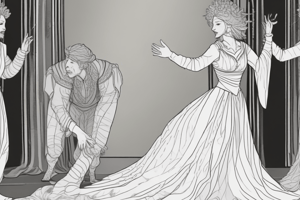Podcast
Questions and Answers
What is the main focus of the Stanislavski Method?
What is the main focus of the Stanislavski Method?
Which acting technique involves immersing the actor in the character's world and experiences?
Which acting technique involves immersing the actor in the character's world and experiences?
What is the key focus of the Brechtian Technique?
What is the key focus of the Brechtian Technique?
What is the primary emphasis of the Meisner Technique?
What is the primary emphasis of the Meisner Technique?
Signup and view all the answers
What does 'stage presence' in acting encompass?
What does 'stage presence' in acting encompass?
Signup and view all the answers
How can an actor develop strong physicality in performance?
How can an actor develop strong physicality in performance?
Signup and view all the answers
What is character development in acting focused on?
What is character development in acting focused on?
Signup and view all the answers
What is improvisation in acting aimed at developing?
What is improvisation in acting aimed at developing?
Signup and view all the answers
How can an actor create strong characterisation through dialogue?
How can an actor create strong characterisation through dialogue?
Signup and view all the answers
What is essential in creating a believable and engaging character?
What is essential in creating a believable and engaging character?
Signup and view all the answers
Study Notes
Drama Key Terms Performance: Diving into Acting, Stage Presence, Character Development, Physicality, Improvisation, and Characterisation
Drama, a captivating art form that transcends time and culture, is a blend of performance, creativity, and self-expression. Key terms in drama performance guide us through the intricate world of acting, character development, and stage presence. Here, we will explore six fundamental aspects of drama performance: acting techniques, stage presence, character development, physicality in performance, improvisation, and characterisation.
1. Acting Techniques
Acting techniques are the methods and strategies that actors use to create believable and engaging performances. These techniques aim to achieve naturalism, emotion, and authenticity on stage or screen. Some popular acting techniques include:
- Stanislavski Method: Developed by Konstantin Stanislavski, this technique focuses on creating truthful, emotional, and realistic performances through the actor's inner experience.
- Meisner Technique: Developed by Sanford Meisner, this technique emphasizes the actor's instincts and reactions to their scene partners.
- Method Acting: This technique involves the actor immersing themselves in the character's world, emotions, and experiences.
- Brechtian Technique: Developed by Bertolt Brecht, this technique encourages actors to emphasize social and political themes, and to alienate the audience from the performance.
2. Stage Presence
Stage presence refers to an actor's ability to capture and hold the audience's attention. It encompasses body language, vocal tone, charisma, and confidence. To develop stage presence:
- Maintain good posture and body language
- Use appropriate vocal projection and inflection
- Be aware of your surroundings and engage with the audience
- Be confident and secure in your role
3. Character Development
Character development involves creating a fully realized, complex character that is believable and engaging. To create a compelling character:
- Start with a strong backstory
- Develop the character's motivations, goals, and obstacles
- Consider the character's physical attributes, attitudes, and speech patterns
- Make the character relatable, empathetic, and dynamic
4. Physicality in Performance
Physicality refers to the use of the body in a dramatic performance. It encompasses movement, gestures, and facial expressions. Physicality is essential in creating a believable and engaging character, and to develop strong physicality:
- Practice good posture and body alignment
- Develop natural and expressive movement
- Use facial expressions and gestures to convey emotions
- Be aware of your surroundings and use space effectively
5. Improvisation
Improvisation is the art of creating a performance on the spot, without a script. Improvisation skills are valuable for actors, as they help to develop quick-thinking, adaptability, and creativity. To improve your improvisation skills:
- Practice active listening and responding
- Develop a strong understanding of your character and their motivations
- Be open to new ideas and suggestions
- Be confident in your ability to think on your feet
6. Characterisation
Characterisation is the process of creating a believable and engaging character through the use of dialogue, actions, and physicality. To create strong characterisation:
- Develop a strong understanding of your character's motivations, goals, and obstacles
- Use dialogue to reveal character and convey emotion
- Use physicality to convey emotion and character, without resorting to clichés
- Be consistent and true to your character
By combining these six key terms in drama performance, actors can develop a strong and engaging performance. Remember, drama is a collaborative process, and actors should always be open to learning and growing in their craft. Happy acting!
Studying That Suits You
Use AI to generate personalized quizzes and flashcards to suit your learning preferences.
Description
Test your knowledge of key terms in drama performance including acting techniques like Stanislavski Method and Meisner Technique, stage presence, character development, physicality in performance, improvisation, and characterisation.




